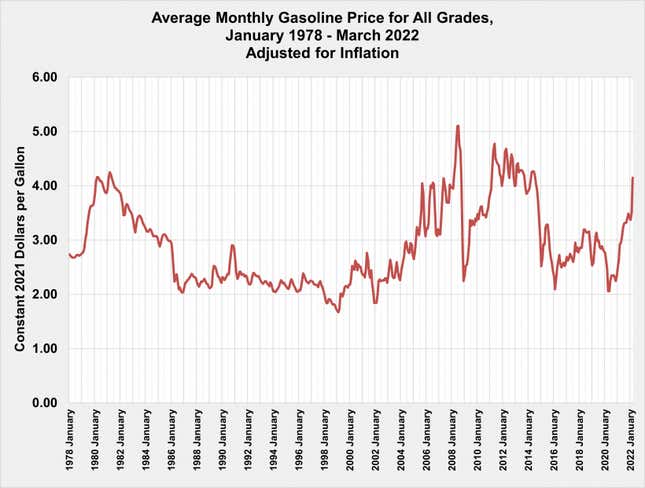Have you experienced sticker shock at the gas pump recently? The average price of a gallon of gasoline is $3.78 across the country as of October 4, 2023, and it went as high as $5.02 a gallon in June, so it’s hard not to think, “Jesus, that much?” when filling your tank. But despite appearances fanned by self-serving political rhetoric during an election year, in practical terms, gasoline is cheaper than it was in most people’s personal “good old days,” and only marginally more expensive than it was during the best time in US history to buy gasoline.
“Gas prices are too high (and it’s the other guy’s fault)“ is a familiar refrain in politics—an easy dunk—but the actual numbers tell a totally different story.
Price of gas vs. inflation
Table of Contents
When viewed in terms of actual dollars, gas prices over time are a disaster. Just look at this chart (from data from the US Energy Information Administration):
Alarming, as Elon Musk might tweet. But that chart is not inflation-adjusted, and focusing on the nominal price of anything is a sucker’s game. Gasoline costs more actual dollars per gallon than it did in 1978, when the average cost was under a dollar per, but each of those dollars has less value in 2023 because of inflation. Once the gas chart is adjusted for the rate of inflation, it’s much more soothing:

There are peaks and valleys caused by all kinds of factors, and the interplay between fluctuations in the price of oil and the inflation rate itself is a can of worms that is way above my pay grade, but overall, adjusted-for-inflation charts don’t indicate a skyrocketing price of gasoline.
It does go up, though, especially when you look at the 1990s. Gas started the decade at $1.12/gallon (non-adjusted) in 1990 and ended at $1.12/gallon in 1999. That decade of stability represents the best-case-scenario for gasoline purchasing since the invention of the car. Gas is a little more expensive now than it was then, but not by much.
Gasoline vs. fuel efficiency, or why the 1970s were the worst time to drive
Back in 1978, the average fuel efficiency of cars in the United States was around 19 miles per gallon and the average price of a gallon of gas, in 2023 dollars, was $4.37. So 10 gallons of gas would cost $43 and take you 190 miles, or $.23 a mile. In October 2023, average mpg across all vehicles (including SUVs) is around 25 mpg, and gas costs $3.78. So you’re paying around $37 for 250 miles of driving, or around $.15 a mile.
Back in the $2-a-gallon (adjusted for inflation) days of 1992, the average fuel efficiency of a light-duty vehicle was around 19 mpg at $20 to go 190 miles, you paid $.11 a mile. In 2023, it’s up to 26 mpg. So $.15 a gallon. That works out to $.4 per mile more expensive than the best possible time for driving in recent history, but even that isn’t the whole story—even if we ignore the fact that a lot of people choose to drive less-efficient vehicles in 2023, the math still shows it costs about the same to burn gas now as it did back then.
Gasoline prices vs. real wages
When you start comparing adjusted-for-inflation wages of workers in 2023 vs. workers in 1992, the difference in the price of gasoline nearly vanishes.
In 1992, during the golden age of gas prices, the average US worker earned about $56,684 a year when adjusted for inflation, or $27.16. an hour, so it took about five minutes of work at $.45 a minute to purchase a gallon of gasoline that would take you 19 miles. That’s about 16 seconds of work for each mile traveled.
In 2023, the average US salary is $59,428 or $28.34 per hour, or $.47 a minute. So it takes about 8 minutes of work to buy a gallon of gas that will take you 26 miles. That’s about 18 seconds of work per mile. While it’s true the average worker has to work two extra seconds per gallon, if that matters to you, you can drive a hybrid—an option not available in the 1990s.
